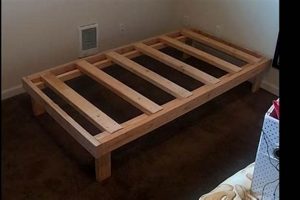The construction of a sleeping platform utilizing repurposed wooden shipping components and a do-it-yourself approach represents an exercise in sustainable furniture creation. An example includes sourcing reclaimed wood platforms, disassembling and preparing the material, and then reassembling into a supportive base for a mattress, often customized to specific dimensions and aesthetic preferences.
This method of furniture construction offers numerous advantages, including cost-effectiveness, environmental responsibility through resource reuse, and the potential for personalization. Historically, the practice of repurposing materials for furniture stems from periods of economic hardship and a growing awareness of waste reduction and sustainable living practices, evolving from necessity to a conscious design choice.
The subsequent discussion will delve into various aspects of this building approach, encompassing material selection, design considerations, construction techniques, and finishing options, providing a comprehensive overview for individuals interested in pursuing this project.
Construction Guidance
The following guidelines aim to optimize the creation of a sleeping platform from reclaimed wood components, ensuring structural integrity and aesthetic appeal.
Tip 1: Material Selection: Prioritize heat-treated (HT) marked components, as these have undergone a sanitization process and are less likely to harbor pests or chemicals. Avoid those marked with MB (methyl bromide) due to toxicity concerns.
Tip 2: Structural Integrity: Thoroughly inspect each component for damage, rot, or weak points. Reinforce compromised areas with additional wood supports or replace them entirely to ensure a stable and durable framework.
Tip 3: Surface Preparation: Sanding all surfaces is crucial to remove splinters, rough edges, and potential contaminants. Begin with a coarse grit sandpaper and gradually progress to finer grits for a smooth finish.
Tip 4: Design Considerations: Plan the dimensions and configuration carefully to accommodate the mattress size and desired height. Account for any protruding nails or staples during the planning phase to avoid potential hazards.
Tip 5: Secure Assembly: Utilize appropriate fasteners, such as screws and bolts, to ensure a robust and long-lasting structure. Pre-drilling pilot holes is recommended to prevent wood splitting during assembly.
Tip 6: Finishing Options: Apply a sealant or finish to protect the wood from moisture and wear. Consider using non-toxic, low-VOC finishes to minimize environmental impact and potential health risks.
Tip 7: Ventilation Considerations: Ensure adequate spacing between the wood components to allow for proper mattress ventilation, preventing the build-up of moisture and potential mold growth.
Tip 8: Safety Measures: Round off any sharp edges or corners to minimize the risk of injury. Consider adding headboards or footboards for added safety and aesthetic appeal.
Adherence to these recommendations will contribute to the creation of a secure, aesthetically pleasing, and environmentally conscious sleeping platform.
The ensuing section will provide insights into common challenges and troubleshooting techniques encountered during this building process.
1. Sustainability
The construction of sleeping platforms from reclaimed wooden components aligns with the principles of sustainability by reducing reliance on newly manufactured materials and diverting waste from landfills. This approach addresses environmental concerns associated with deforestation and resource depletion inherent in traditional furniture production.
- Waste Reduction
The use of discarded shipping components directly reduces waste generation. Wooden platforms, often deemed unusable by commercial entities, find a second life as functional furniture, minimizing the volume of material entering waste streams. This practice contributes to a circular economy by extending the lifespan of existing resources.
- Reduced Carbon Footprint
Repurposing materials reduces the carbon footprint associated with manufacturing new furniture. The energy-intensive processes of logging, transporting, and processing raw materials are avoided, resulting in a lower overall environmental impact. Choosing locally sourced reclaimed components further minimizes transportation emissions.
- Resource Conservation
Employing reclaimed materials lessens the demand for virgin timber, conserving forests and their ecological services. By reducing the need to harvest new trees, habitat preservation is supported, and biodiversity is protected. Sustainable forest management practices become less critical as reliance on newly harvested wood decreases.
- Promotion of a Circular Economy
The practice of repurposing wooden components for furniture promotes a circular economy model, wherein materials are continually reused and recycled. This approach reduces dependence on linear “take-make-dispose” economic systems, fostering a more sustainable and resilient resource management strategy.
The interconnectedness of these facets underscores the contribution of this building method to environmental sustainability. The decision to construct a sleeping platform from reclaimed wood components represents a tangible commitment to resource conservation and waste reduction, aligning with broader efforts to promote environmentally responsible practices.
2. Cost-Effectiveness
The construction of a sleeping platform using reclaimed wood components frequently presents a more economical alternative compared to purchasing manufactured furniture. The primary driver of cost savings is the reduced expenditure on raw materials. While new lumber can be a significant expense, reclaimed components are often obtainable at minimal or no cost. This factor alone substantially diminishes the overall project budget. Additional savings may accrue from minimizing labor expenses, assuming the builder undertakes the project independently. The utilization of pre-existing materials negates the need to purchase precisely dimensioned lumber, potentially reducing material waste and associated costs. The extent of cost savings depends on several variables, including the availability of reclaimed materials, the complexity of the design, and the builder’s skill level.
Instances of individuals constructing bed frames for under $50, utilizing primarily free reclaimed wood, are commonplace. This cost-effectiveness allows for the allocation of resources to other areas, such as a higher-quality mattress or bedding. While there may be costs associated with fasteners, tools, and finishing materials, these typically remain significantly lower than the price of a commercially produced bed frame. Furthermore, the longevity of a well-constructed reclaimed wood bed frame can provide long-term economic benefits by delaying the need for replacement.
In conclusion, the cost-effectiveness of constructing a sleeping platform from reclaimed wooden components is a notable advantage. Reduced material costs, minimized waste, and the potential for long-term durability contribute to its economic appeal. The inherent variability in project costs necessitates careful planning and resource management to maximize potential savings. Despite potential challenges in material acquisition and project execution, the cost-effective nature of this building method remains a compelling factor for individuals seeking affordable furniture solutions.
3. Customization
The inherent adaptability of working with reclaimed wooden components offers a significant degree of design flexibility in the construction of sleeping platforms. This customization potential allows for tailoring the final product to specific needs, preferences, and spatial constraints.
- Dimensional Adaptation
The modular nature of reclaimed wooden components facilitates precise dimensional adjustments. The sleeping platform can be scaled to accommodate diverse mattress sizes, ranging from twin to king. Furthermore, the height can be modified to suit individual preferences or to integrate storage solutions underneath. Examples include crafting a low-profile platform for a minimalist aesthetic or elevating the frame to provide under-bed storage. The ability to alter dimensions ensures compatibility with various room layouts and user needs.
- Aesthetic Personalization
Reclaimed wooden components exhibit unique characteristics, including variations in grain pattern, color, and surface texture. These inherent attributes allow for a high degree of aesthetic personalization. The selection of specific components based on their visual appeal enables the creation of a sleeping platform with a distinct character. Additionally, various finishing techniques, such as staining, painting, or distressing, can further enhance the aesthetic customization. Individuals can achieve a rustic, modern, or eclectic style through careful material selection and finishing treatments.
- Integrated Functionality
The construction process allows for the seamless integration of functional features. Headboards, footboards, and side rails can be incorporated into the design to enhance comfort and safety. Furthermore, storage compartments, such as drawers or shelves, can be integrated to maximize space utilization. Examples include adding a built-in bedside table or incorporating a bookshelf into the headboard. The capacity to integrate functional elements transforms the sleeping platform from a simple support structure into a multi-functional piece of furniture.
- Structural Modification
Within the bounds of sound engineering principles, the structural configuration can be modified to suit specific requirements. Reinforcements can be added to increase load-bearing capacity, and the frame can be adapted to accommodate uneven floor surfaces. Moreover, the structural design can be altered to incorporate unique aesthetic elements, such as angled supports or decorative cutouts. These modifications require careful planning and execution to ensure structural integrity and stability. The capability to adjust the structural configuration expands the possibilities for creating a distinctive and durable sleeping platform.
These customizable features collectively empower individuals to construct sleeping platforms that precisely meet their individual needs and aesthetic preferences. The inherent adaptability of reclaimed wooden components, combined with informed design and construction practices, enables the creation of furniture that is both functional and aesthetically compelling.
4. Structural Integrity
The sustained performance and safety of a sleeping platform constructed from reclaimed wood components are fundamentally dependent on its structural integrity. The inherent characteristics of reclaimed wood, including potential variations in density, previous use, and unseen damage, necessitate meticulous assessment and construction practices to ensure the framework can adequately support the intended load. Compromised structural integrity can lead to premature failure, instability, and potential injury to the user. The cause-and-effect relationship is direct: deficient construction methods or compromised materials inevitably result in a weakened structure. Examples of structural deficiencies include inadequate joinery, use of warped or rotting wood, and insufficient support for the mattress. The practical significance of understanding this connection lies in prioritizing robust construction techniques and rigorous material inspection during the building process.
Securing structural integrity in a “pallet bed frame diy” project involves several key considerations. Joint strength is paramount; mortise-and-tenon, dovetail, or properly reinforced butt joints, secured with appropriate adhesives and fasteners, are essential. The type and quantity of fasteners must be appropriate for the wood species and load requirements. Reinforcement strategies, such as adding cross-bracing or vertical supports, distribute weight and prevent sagging or warping. Real-world examples of successful structural integration include designs that distribute the mattress weight across multiple support members and utilize interlocking joinery to enhance stability. Regularly inspecting the platform for signs of stress or wear is critical for maintaining its integrity over time. Addressing any identified weaknesses promptly prevents further deterioration.
In summary, the structural integrity of a sleeping platform constructed from reclaimed wood components is paramount to its long-term functionality and safety. The challenges associated with using reclaimed materials demand careful attention to material selection, joint construction, and reinforcement strategies. A proactive approach to inspection and maintenance further contributes to the sustained integrity of the structure. While design aesthetics and cost considerations are important factors, they should not compromise the fundamental requirement of a structurally sound and reliable sleeping platform.
5. Material Sourcing
The process of obtaining reclaimed wooden components is a pivotal element in the construction of a sleeping platform. The selection of appropriate materials directly impacts the structural integrity, aesthetic appeal, and overall sustainability of the finished product. Sourcing channels, material quality, and pretreatment considerations are critical factors in this endeavor.
- Commercial and Industrial Channels
Businesses that routinely receive shipments on wooden platforms represent a primary source. These include warehouses, distribution centers, and manufacturing facilities. Direct engagement with these entities may yield a consistent supply of materials. Considerations include transportation logistics and potential for securing large quantities, which may require storage space. The advantages lie in volume and potential for establishing ongoing relationships.
- Online Marketplaces and Classifieds
Digital platforms facilitate the connection between individuals seeking to dispose of unwanted wooden platforms and those seeking materials for construction projects. These platforms offer accessibility and often provide detailed descriptions of available materials. However, quality control and verification of the wood’s history (e.g., previous contents, treatments) become the responsibility of the individual sourcing the components. The benefit is convenience, while the challenge lies in due diligence.
- Construction and Demolition Sites
Sites undergoing construction or demolition activities may yield reusable lumber, including wooden platform components. Obtaining permission from site managers is imperative. Materials sourced from these locations may require extensive cleaning and preparation due to exposure to the elements and potential contaminants. While potentially cost-effective, safety precautions and thorough inspection are paramount.
- Local Recycling Centers and Waste Management Facilities
Certain recycling centers and waste management facilities may accept wooden platforms for processing or redistribution. Contacting these entities to inquire about availability and any associated fees is advisable. This sourcing method aligns with sustainability principles by diverting materials from landfills. However, the available selection and quality may vary considerably.
The selection of a material sourcing strategy is contingent on factors such as project scale, budget constraints, and desired material quality. Regardless of the chosen method, thorough inspection and preparation are essential for ensuring the structural soundness and aesthetic suitability of the wooden components used in the construction of a sleeping platform. Sourcing decisions should align with both the immediate project requirements and broader sustainability goals.
6. Safety Measures
Construction of a sleeping platform from reclaimed wooden components necessitates diligent adherence to safety protocols. The variability in material condition and the do-it-yourself nature of the project introduces potential hazards. Disregard for safety measures can lead to physical injury during the construction process, or compromise the structural integrity of the finished platform, resulting in potential harm to the user. For example, the presence of protruding nails or splinters on reclaimed wood can cause lacerations. Failure to properly secure joints can result in structural collapse. Consequently, safety measures are an indispensable component of any “pallet bed frame diy” undertaking, directly influencing the user’s well-being and the furniture’s longevity.
Implementation of appropriate safety protocols involves several practical considerations. Protective eyewear is essential during sanding, cutting, and assembly to prevent eye injuries. The use of work gloves minimizes the risk of splinters and abrasions. Power tools must be operated with caution, adhering to manufacturer guidelines, and utilizing safety guards. Furthermore, workspace organization is crucial to prevent tripping hazards and ensure adequate maneuverability. Addressing potential issues such as wood with unknown chemical treatments is important. Choosing heat-treated (HT) marked wooden components over methyl bromide (MB) treated options exemplifies proactive hazard mitigation. Securing the platform to prevent movement, rounding sharp edges to avoid accidental contact, and applying non-toxic finishes represent additional safety measures.
In conclusion, the successful and safe construction of a sleeping platform hinges on the consistent application of safety measures throughout the entire process. The potential hazards associated with reclaimed materials and do-it-yourself construction demand a proactive approach to risk management. Prioritizing safety not only prevents injuries but also contributes to the creation of a durable and reliable piece of furniture. Integrating these precautions into every stage of the “pallet bed frame diy” project translates into both a safer building experience and a safer final product.
Frequently Asked Questions
The following addresses common inquiries regarding the design, construction, and utilization of sleeping platforms constructed from reclaimed wooden components.
Question 1: What are the primary advantages of utilizing reclaimed wood in constructing a sleeping platform?
Reclaimed wood offers several benefits, including reduced material costs, environmental sustainability through resource reuse, and the potential for unique aesthetic customization.
Question 2: How can the structural integrity of a sleeping platform constructed from reclaimed wood be ensured?
Structural integrity is ensured through careful material selection, robust joint construction using appropriate fasteners and adhesives, and reinforcement strategies such as cross-bracing.
Question 3: What types of reclaimed wood should be avoided for constructing a sleeping platform?
Wooden components treated with methyl bromide (MB) should be avoided due to toxicity concerns. Preference should be given to heat-treated (HT) components.
Question 4: What are the essential safety precautions to consider during the construction process?
Essential safety precautions include wearing protective eyewear and gloves, utilizing power tools safely, ensuring workspace organization, and addressing potential hazards associated with the wood’s previous treatments.
Question 5: How can the longevity of a sleeping platform constructed from reclaimed wood be maximized?
Longevity is maximized through proper material selection, robust construction techniques, application of protective finishes, and regular inspection and maintenance.
Question 6: What considerations should be given to mattress ventilation in a reclaimed wood sleeping platform?
Adequate spacing between wooden components is crucial for ensuring proper mattress ventilation, preventing moisture build-up and potential mold growth.
These responses offer guidance for individuals considering this building approach. The information provided is intended to facilitate informed decision-making and promote safe and effective construction practices.
The subsequent section will present case studies illustrating diverse applications and design approaches in the construction of sleeping platforms using reclaimed wooden components.
Conclusion
The preceding discussion has explored the various facets of pallet bed frame diy, encompassing material considerations, design principles, construction techniques, and safety protocols. The information presented underscores the potential for creating functional and aesthetically pleasing furniture through the resourceful utilization of reclaimed wooden components. Emphasis has been placed on the importance of structural integrity, responsible material sourcing, and adherence to safety measures to ensure both the durability and user safety of the finished product.
The construction of a sleeping platform utilizing repurposed materials represents a tangible step towards sustainable living. Individuals are encouraged to approach such projects with diligence and a commitment to quality craftsmanship, recognizing the broader implications for resource conservation and waste reduction. Continued innovation in design and construction techniques will further enhance the viability and appeal of this environmentally conscious approach to furniture creation.


![Build a Strong DIY Boxing Bag Frame [Project Guide] The DIY Hub: Creative Crafts, Repairs & Life Hacks Build a Strong DIY Boxing Bag Frame [Project Guide] | The DIY Hub: Creative Crafts, Repairs & Life Hacks](https://craftingdiycenter.com/wp-content/uploads/2025/07/th-2040-300x200.jpg)




